World Day for AudioVisual Heritage 2012
27 October 2012
Audiovisual heritage memory? the clock is ticking
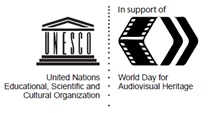 This is the official website, hosted by IASA on behalf of CCAAA (Co-ordinating Council of Audiovisual Archives Associations), for the 2012 World Day for Audiovisual Heritage.
This is the official website, hosted by IASA on behalf of CCAAA (Co-ordinating Council of Audiovisual Archives Associations), for the 2012 World Day for Audiovisual Heritage.
 UNESCO declared October 27 as the World Day for AV Heritage to raise awareness of the significance of AV documents and to draw attention to the need to safeguard them. Every year, activities are organized by different institutions worldwide around a theme to drum up interest in the event. More ...
UNESCO declared October 27 as the World Day for AV Heritage to raise awareness of the significance of AV documents and to draw attention to the need to safeguard them. Every year, activities are organized by different institutions worldwide around a theme to drum up interest in the event. More ...
Message from the UNESCO Director-General: English
English  Français
Français  Español
Español  Русский
Русский
The theme for 2012 is:
“Audiovisual heritage memory? the clock is ticking”
Click the map to locate events or browse the full list below
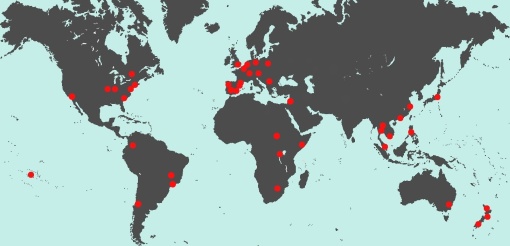
Get involved!
- Link to this page: www.iasa-web.org/world-day-audiovisual-heritage
- Let us know how your organisation marked this important occasion. Read the instructions
ABS CBN Film Archives (Philippines) restores Ishmael Bernal’s Himala (1982)
A Long Awaited Miracle
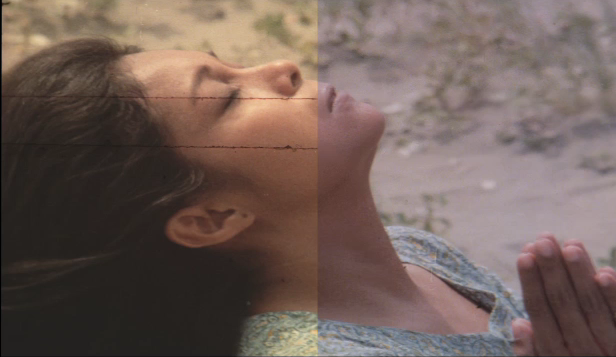
Image of Elsa (Nora Aunor) praying.
(L): original print with scratches; (R): enhanced image
The Philippines has an illustrious cinematic history with around 8,000 films having been produced since 1919*. It is the regrettable truth that many of these films are now lost or have been ruined. Even if there are a small number of prints that still exist which are being preserved, they are gradually and inevitably degrading. With time against us, actions must be taken to ensure that copies of our cinematic gems will be available for future generations to appreciate and continue to preserve. Film restoration is one way to address this issue and the largest television network in the Philippines, ABS-CBN, which currently houses the premier film archives in the Philippines, has been one of the institutions in the country that has realized the importance of restoring films. In partnership with Central Digital Laboratory (CDL), ABS-CBN has taken this matter to heart and is currently at the helm of a film restoration and HD conversion project wherein certain films of cultural significance and international acclaim have been selected to be restored.
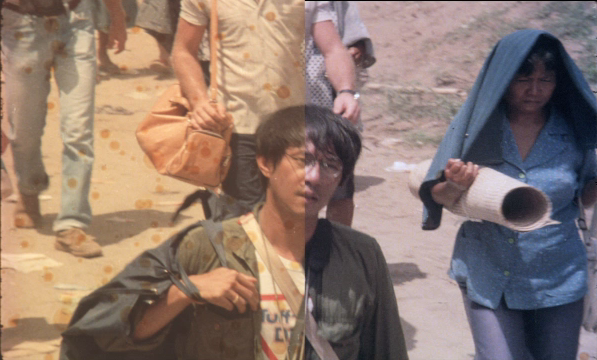
Image of Orly (Spanky Manikan).
(L): stained original print; (R): enhanced image
Ishmael Bernal’s Himala (Miracle. 1982) is the first film that has undergone restoration. Bernal himself described the film as "… not just the story of a couple of characters. It is also the story of a society. And that is Himala. What I show in Himala is the picture of a society that is ill. A society which has no recourse but to cling to apparitions and miracles. It is not important if there really was a miracle or not. What is important is the need of a people to believe." (Translated from Filipino by scriptwriter Ricardo Lee). I was fortunate enough to watch Himala for the first time during college. Knowing how Bernal meticulously crafts his scenes, I remember loving how many of the film’s scenes played out. One such scene is when Nimia coyly performs a few magic tricks for some children, their silhouettes against the setting sun. In the restored HD version, the same scene is even more poignant. It is also remarkable how details that were not as noticeable then, now breathe a new life into the film. The restored HD version undoubtedly enhances the whole cinematic experience Himala has to offer but it must also be known that the whole process of restoring and converting it to HD was nothing short of a miracle.
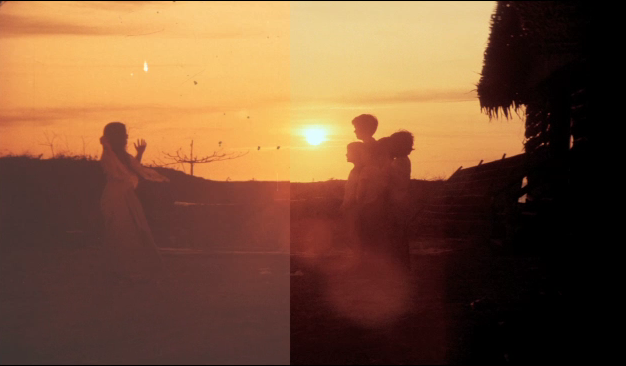
Image of Nimia (Gigi Dueñas) performing tricks for some children.
(L): original print with drop outs and specks; (R): enhanced image
It took 8 months to complete its restoration, starting with the scrupulous process of choosing the best available 35mm prints of the film. Four copies of prints were checked and two of which were chosen to be the source of the restored version. ABS-CBN then tied up with CDL, which handled the impairments of the prints and the audio. CDL painstakingly cleaned the scratches, specks, dirt, and flicker on the prints. For the audio, they had to clean up the noise, pops, crackles, hiss, hum, and also had to deal with the audio being out of sync.
The restored version was then quality checked around five times with corresponding corrections being made each time to enhance the video and audio. After all the adjustments that have been made and the best possible output has been attained, the restored and HD version of Himala will premier on December 4, 2012 to celebrate its completion and to commemorate its 30th anniversary.
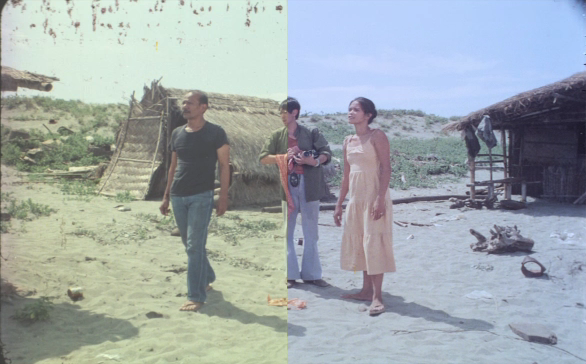
Image of Mang Igme (Cris Daluz), Orly (Spanky Manikan), and Nimia (Gigi Dueñas).
(L): original print with adhesive residue; (R): enhanced image
“Walang himala! Ang himala ay nasa puso ng tao! Nasa puso nating lahat.” [There are no miracles! It is all inside us! We make the miracles ourselves.] Who can forget these iconic lines in the film spoken by Nora Aunor’s character, Elsa? All the hours, effort, and hard work that was put into the restoration of the chosen films were done with dedication and heart. Despite the difficulties that arise in restoring films, the people involved in this project chose to make this miracle happen. This will not only allow a new generation to appreciate this classic film but it will hopefully also raise the awareness of the importance of the preservation and restoration of Philippine films.
As Elsa aptly expressed in the film, “ . . . Kung wala na ang lahat. Kung kalansay na lang tayo. Ang matitira’y ang sinasabi mong sining.” [When all is over and we’re reduced to bones . . . what remains is what you call ‘art’.]
*The birth of Philippine cinema is a much debated topic and 1919 would be regarded as its beginning if Dalagang Bukid is considered to be the first Filipino Film.
Asian Film Archive presents filmmakers' perspectives
Asian Film Archive presents: filmmakers' perspectives
During the 2011 World Day for AV Heritage, the Asian Film Archive (AFA) called for filmmakers to express what cinema or the loss of their cinematic heritage means to them. This year, the AFA presents some of the original works of filmmakers who responded to the call.
Check them out at http://vimeo.com/user9048690/videos.
We, historical. by Nawapol Thamrongrattanarit from Asian Film Archive on Vimeo.
Secondary School by Wesley Leon Aroozoo from Asian Film Archive on Vimeo.
Reason For Our Love by Chew Tee Pao from Asian Film Archive on Vimeo.
Association for Recorded Sound Collections podcasts demonstrate importance of historical sound recordings
ARSC (Association for Recorded Sound Collections) is making available two recently completed 3 to 4 minute podcasts.
These are part of an ARSC series of podcasts entitled, “Echoes of History” to demonstrate to the public the importance of historical sound recordings and their preservation. They illustrate and contextualize the type of historic audio ARSC is dedicated to preserving and making available.
ARSC Podcast: Echoes of History – "The Crystal Palace"
ARSC Podcast: Echoes of History – "First Sound Bites"
British Library holds a 3-day training course on preserving audio collections
Understanding and preserving audio collections
Preservation Advisory Centre 3-day Course
22-24 October 2012
The British Library Centre for Conservation
96 Euston Road, London NW1 2DB
Taking you from ‘what is it?’ through collection management issues to preservation strategies, this three day course provides an overview of managing and preserving audio material, with an emphasis on digitisation for preservation and access.
The course is aimed at people with responsibility for creating, managing and using audio collections. Whilst no hands-on experience is necessary, it is useful to have identified a collection to which the theory and practical elements of this course will be applied in order to get the most from it. The training is provided by members of the British Library Sound & Vision department and is structured to allow for plenty of informal discussion and information-sharing. A short pre-course reading list will be circulated to participants in advance. The course was fully subscribed.
Celebrations in Thailand
World Day for AV Heritage
Audiovisual heritage memory? The clock is ticking.
Saturday, 27 October 2012
Nopparatana Room, Royal Hotel (Rattanakosin Hotel)
Ratchadamnoen Klang Road, Bangkok
09.30 hr - Registration
10.00 hr - Procession to campaign for public awareness of World Day for AV Heritage
10.30 hr - Mr. Dome Sukwong, Director of Thai Film Archive (Public Organization), reports the background of World Day for AV Heritage
- Mrs. Tuenjai Sinthuvnik, Deputy Director-General of the Public Relations Department, in her capacity as President of SEAPAVAA, reads the message of World Day for AV Heritage 2012
- Mr. Teerapong Sodasri, Director-General of the Public Relations Department, delivers the opening speech marking World Day for AV Heritage 2012
- A film show by the Thai Film Archive
- Mr. Teerapong Sodasri, Director-General of the Public Relations Department and Air Chief Marshal Thares Punsri, Chairman of the National Broadcasting and Telecommunications Commission, present video tapes to Mr. Sahawat Naenna, Director-General of the Fine Arts Department for the National Archives in Commemoration of H.M. the King’s Golden Jubilee. The presentation is part of the U-matic tape preservation project in celebration of His Majesty the King’s 84th birthday, Her Majesty the Queen’s 80th birthday, and His Royal Highness the Crown Prince’s 60th birthday.
- H.E. Mr. James Joseph Wise, Ambassador of Australia to Thailand, presents the collection of rare 78 RPM shellac recordings, featuring His Majesty the King’s compositions, to Mr. Teerapong Sodasri, Director-General of the Public Relations Department. The collection was donated by Mr. Michael Waterhouse, an Australian national, to the Museum and Archive of the Public Relations Department of Thailand through the National Film and Sound Archive of Australia
11.00 hr - Discussion on “Audiovisual heritage memory? The clock is ticking.”
- Presentation by Mr. Pluetipol Prachumphol, President of the Antique Phonograph and Gramophone Thai Society, in commemoration of the 100th anniversary of the Royal Anthem, composed by King Vajiravudh (Rama VI) in 1913
- Presentation in remembrance of Mr. Sanpasiri Viriyasiri, a pioneer of television service in Thailand and a former official of the Public Relations Department, and in commemoration of the centennial anniversary of the birth of Mr. Chamnong Ransikul, also a pioneer of television service in Thailand and a former official of the Public Relations Department. Joining the presentation are Mrs. Ari Nakdontree, a former television actress and presenter; Mr. Junsiri Virayasiri, son of Mr. Sanpasiri Virayasiri; Mr. Dome Sukwong, Director of Thai Film Archive (Public Organization); and Ms. Kannika Chivapakdee, Director of Museum and Archive of Public Relations Department.
- Presentation of the U-matic tape preservation project under the cooperation of the Public Relations Department and the National Broadcasting and Telecommunications Commission
13.00 hr Lunch
กำหนดการงานวันมรดกโสตทัศน์โลกแห่งประเทศไทย
“มรดกโสตทัศน์ไม่คอยท่า วันเวลาไม่คอยใคร”
Audiovisual heritage memory? The clock is ticking.
วันเสาร์ที่ ๒๗ ตุลาคม ๒๕๕๕
ณ ห้องนพรัตน์ โรงแรมรัตนโกสินทร์ ถนนราชดำเนิน สนามหลวง กรุงเทพมหานคร
*****************************
๐๙.๓๐ น. - ลงทะเบียนรับของที่ระลึก
๑๐.๐๐ น. - เดินขบวนรณรงค์วันมรดกโสตทัศน์โลกแห่งประเทศไทย
๑๐.๓๐ น. - รายงานความเป็นมาของวันมรดกโสตทัศน์โลก
นายโดม สุขวงศ์ ผู้อำนวยการหอภาพยนตร์ (องค์การมหาชน)
- อ่านสารวันมรดกโสตทัศน์โลก โดย นางเตือนใจ สินธุวณิก รองอธิบดีกรมประชาสัมพันธ์
ในฐานะนายกสมาคมอนุรักษ์สื่อโสตทัศน์แห่งเอเชียตะวันออกเฉียงใต้และแปซิฟิก
- กล่าวเปิดงานวันมรดกโสตทัศน์โลกแห่งประเทศไทย ๒๕๕๕
โดย นายธีระพงษ์ โสดาศรี อธิบดีกรมประชาสัมพันธ์
- ชมภาพเคลื่อนไหว
- มอบดีวีดีภาพเคลื่อนไหวพระราชกรณียกิจของพระบาทสมเด็จพระเจ้าอยู่หัวและพระราชวงศ์ จำนวน ๔๐๐แผ่น
(ตามโครงการอนุรักษ์เทปยูเมติก เนื่องในโอกาสเฉลิมพระเกียรติพระบาทสมเด็จพระเจ้าอยู่หัว พระราชพิธีมหามงคลเฉลิมพระชนมพรรษา ๗ รอบ ๕ ธันวาคม ๒๕๕๔) ให้แก่หอจดหมายเหตุแห่งชาติเฉลิมพระเกียรติพระบาทสมเด็จพระเจ้าอยู่หัวภูมิพลอดุลยเดช มอบโดย นายธีระพงษ์ โสดาศรี อธิบดีกรมประชาสัมพันธ์ และ พลอากาศเอก ธเรศ ปุณศรี ประธานกรรมการกิจการกระจายเสียง กิจการโทรทัศน์ และกิจการโทรคมนาคมแห่งชาติ รับมอบโดย นายสหวัฒน์ แน่นหนา อธิบดีกรมศิลปากร
- มอบแผ่นเสียงเพลงพระราชนิพนธ์ชุดแรก ขับร้องและบรรเลงเพลงโดยกรมโฆษณาการ
แผ่น shellac 78 RPM จำนวน ๑๘ แผ่น บริจาคโดย Mr.Michael Waterhouse
ชาวออสเตรเลีย ผ่านทางหอภาพยนตร์และเสียงแห่งชาติออสเตรเลีย (National Film and Sound Archive of Australia) มอบโดย เอกอัคราชทูตออสเตรเลียประจำประเทศไทย นายเจมส์ โจเซฟ ไวส์ (H.E. Mr. James Joseph Wise) ให้แก่ นายธีระพงษ์ โสดาศรี อธิบดีกรมประชาสัมพันธ์
เวลา ๑๑.๐๐ น. เสวนา “มรดกโสตทัศน์ไม่คอยท่า วันเวลาไม่คอยใคร”
- รำลึกวาระครบรอบ ๑ ศตวรรษ (มีนาคม ๒๔๕๖) เนื้อร้องเพลงสรรเสริญพระบารมี พระ
ราชนิพนธ์ พระบาทสมเด็จพระมงกุฎเกล้าเจ้าอยู่หัว รัชกาลที่ ๖
โดย นายพฤฒิพล ประชุมผล นายกสมาคมนักอนุรักษ์เครื่องเล่นกระบอกเสียงและหีบเสียง
ไทย
- รำลึก สรรพสิริ วิรยศิริ และ ๑๐๐ ปี จำนงค์ รังสิกุล
โดย นางอารีย์ นักดนตรี อดีตนักแสดงไทยทีวีช่อง ๔ บางขุนพรหม
นายจุลสิริ วิรยศิริ ทายาท ดร.สรรพสิริ วิรยศิริ
นายโดม สุขวงศ์ ผู้อำนวยการหอภาพยนตร์ (องค์การมหาชน)
น.ส.กรรณิกา ชีวภักดี ผู้อำนวยการพิพิธภัณฑ์และหอจดหมายเหตุกรมประชาสัมพันธ์
- เสนอตัวอย่าง การอนุรักษ์เทปยูเมติก
- รับประทานอาหารกลางวัน
Speech by Mrs. Tuenjai Sinthuvnik
Deputy Director-General of the Public Relations Department
In Her Capacity as President of SEAPAVAA
We come together today in Bangkok, Thailand as part of an international community that is taking part in worldwide events marking the World Day for Audiovisual Heritage, first declared by UNESCO in 2005. Around the world in many nations, concerned governmental and private entities as well as individuals are hosting and participating in workshops, seminars, presentations and other venues to promote awareness and to educate our communities about the importance of audiovisual materials to our world and national heritage.
This year’s theme is “Audiovisual Heritage Memory - The Clock is Ticking,” a very appropriate theme as we struggle to preserve a vanishing audiovisual record sound recordings, television programs, and film and motion pictures, as well as photographs and printed matter, from both the public and private sectors. Why is the clock ticking? The website for the World Day for Audiovisual Heritage notes that AV materials not only represent the primary records of the 20th and 21st centuries but that they are in imminent danger of being lost unless they are transferred to digital format for preservation, with much already having been lost due to the ravages of time, environment, and the chemical processes occurring within the materials themselves.
The Kingdom of Thailand takes great pride in its efforts to preserve that heritage, through the efforts of public bodies such as the Public Relations Department of the Thai government and independent entities such as the Thai Film Archive which have both taken steps in both preservation and digitization of Thailand’s AV heritage. While these have been small in scope compared to the volume of materials, we believe they are not only a start but also a significant step in securing our AV heritage for future generations.
In addition to the digitization of U-matic tapes with the generous financial assistance of the National Broadcasting and Telecommunications Commission, we have also been digitizing still photographs from public and private sources, shellac vinyl recordings in the PRD archives, and an ongoing project to digitize reel-to-reel and cassette recordings of Thailand’s unique hilltribe cultures in the nation’s northern regions.
We are committed to the continued acquisition of such materials and the equipment needed to preserve them for posterity, as well as the training of staff in preservation and digitization techniques. We are committed to the preservation of our heritage, and yes the clock is ticking. With every tick of the clock, something is lost around the world, and with every tick part of our AV heritage takes a step towards oblivion. Nonetheless, with every tick there is also an opportunity, the chance to educate the community, to enhance our knowledge base, and most importantly to save more of our AV heritage for the future.
Opening Speech
Mr.Prawin Phattanaphong
Deputy Director-General of the Public Relations Department
It is my great pleasure to preside over this event today. The preservation of AV materials, both moving images and sound, is an urgent mission which requires us to work against the passage of time, from seconds to minutes, minutes to hours, and hours to days. Day by day, the clock continues to tick and the archivists of Thailand work against time and the deterioration of our AV materials before they fade and their memory cannot be recalled. Therefore, it presents a tremendous burden for our archival institutions.
The Public Relations Department is one of the largest and oldest institutions producing AV materials, both moving images, still images, and sound recordings, having produced AV materials for nearly 80 years. We have already lost a large amount of the AV heritage, and I feel great empathy towards the limited number of public and private institutions working to preserve that heritage. Archivists have to work extremely hard to save this valuable cultural resource of the Thai nation. It is imperative that we endeavor to avoid losing it and allowing it to fade from the memory of society. This material is not only valuable as historical documentation, but also as a research resource for future generations to study and reference in the study of various subjects and societal events.
This year’s theme is about time. Time, however, does not have to be only an adversary it can also be an ally in our mission because, while time ticks away, it also brings us the present and the future. We have to approach time with an attitude of learning from yesterday, applying that knowledge and experience today, and using it to plan for the tomorrow, approaching the future calmly with vision and flexibility. There are many sayings about time, one of which is that time waits for no one – however, it is a stream which can also carry us forward on our mission to preserve our AV heritage as an endowment for our future generations.
World Day for AV Heritage presents us with an opportunity to come together, and on this occasion I would like to express my appreciation and give encouragement to the archivists working against the ticking of the clock and against the deterioration of our AV heritage before it is too late. Although some of the AV heritage has already been irrevocably lost and cannot be recovered, we have much remaining to safeguard and preserve as part of the heritage of the Thai people as well as of mankind.
Now is the time to declare World Day for AV Heritage in Thailand for 2012.
Colombia celebrates the World Day for the first time
The World Day for Audiovisual Heritage, is celebrated for the first time in Colombia
Next Friday, October 26 at 8:30 in the morning at the Oval auditorium in the Jorge Tadeo Lozano University, street 22# 4-96, with the support of The Ministry of Culture, The Colombian Film Heritage Foundation, and Videoelec S.A., will host an academic event, due to the World Day for Audiovisual Heritage celebration.
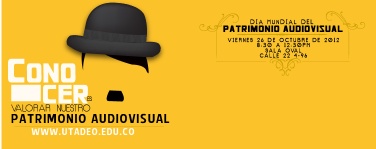
The Jorge Tadeo Lozano University, through its programs on Social Communication - Journalism, and Radio Production, with the support of the Colombian Ministry of Culture, the Colombian Film Heritage Foundation and Videoelec S.A. will organise an academic event, due to the World Day for Audiovisual Heritage celebration, that though it´s on the 27th it´s going to be celebrated next Friday, October 26 at 8:30 in the morning at the Oval auditorium, street 22 # 4- 96.
The agenda includes the UNESCO message for this celebration, the participation of national and international guests, including Luis Romero from Masstech Group USA, Marina Arango from the Colombian Ministry of Culture / Cinematography Direction, and Rito Alberto Torres from the Colombian Film Heritage Foundation (FPFC), who will discuss the subject from different perspectives. Also, films from the beginning of the XX century will be shown, and the university’s Audiovisual Heritage Project will be launched.
The UNESCO in its 1980´s General Conference, proclaimed the celebration of the World Day for Audiovisual Heritage, to call the attention on the safeguard and conservation of the audiovisual heritage, taking into account that the history of the XX and XXI century is written and taken into images and sound, which cares for the world´s memory.
The matter acquires major importance, for in the new cultural industry production environments, audiovisual archives are really the enterprises' monetary resources. Worldwide, the rescue, preservation and management of audiovisual heritage is being strengthened as a developing and identity element, but this work happens with difficulty, for there are not sufficient specialized professionals that successfully face this challenge. For this reason the Jorge Tadeo Lozano University joins this World´s Day celebration and investigates and manifests through specific contributions, such as the creation of the Diploma in Audiovisual Heritage Management, which will begin in August 2013.
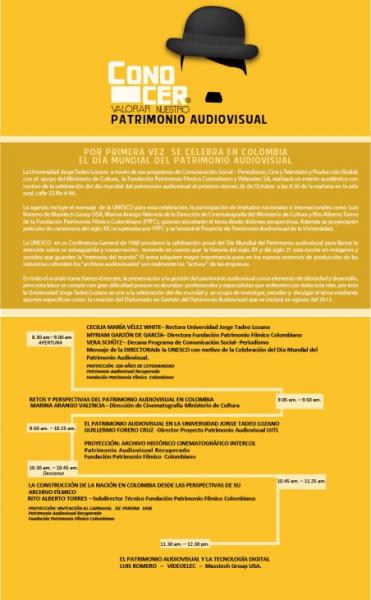
Deutsche Kinemathek Archive presents Earliest Sound Films and Innovations of Yore
For the Unesco World Day of Audiovisual Heritage on 27.10., Mariann Lewinsky and Dirk Förstner present their finds from the Deutsche Kinemathek archive: the first home cinema system Pathé Kok, Proust's Paris (DER SCHÖNSTE PARK VON PARIS: JARDIN DU LUXEMBOURG, France 1912), fashion shows in magnificent hand-painted colors, cheeky Berlin and Vienna operetta numbers with restored sound, all singing, all dancing thanks to the records, and Christian Zwarg – (including MILITÄRISCHE DISZIPLIN, Germany 1910; AM ELTERNGRAB, Germany 1907; LIEBES MÄNNCHEN FOLGE MIR, Germany 1910), the fantastic comedian Rosalie (ROSALIE DANSEUSE, director: Roméo Bosetti, France 1912) and of course superstar Max Linder, king of 1912 cinematography (AMOUREUX DE LA TEINTURIERE, France 1912, and MAX INSZENIERT EINEN FILM, France 1910).
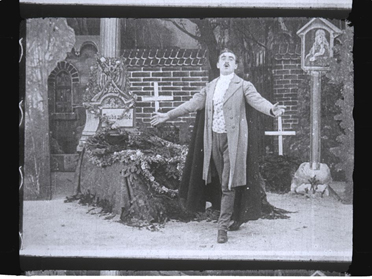
Eunice Martins will be providing a piano accompaniment for the silent films.
27 October, 7:00 pm, Cinema 2
http://www.arsenal-berlin.de/en/calendar/single-view/calendar/2012/octob...
Documentary film screening by Sociedad General de Autores y Editores (SGAE), Spain
The Sociedad General de Autores y Editores (SGAE), the main IP  collecting society for songwriters, composers and music publishers in Spain, is organising a special screening and discusssion on the occasion of the World Day for Audio Visual Heritage.
collecting society for songwriters, composers and music publishers in Spain, is organising a special screening and discusssion on the occasion of the World Day for Audio Visual Heritage.
http://www.sgae.es/actualidad/agenda-cultural/agenda-cultural-madrid/
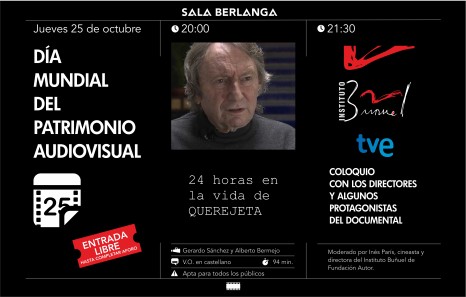
Madrid, Thursday October 25, admission free
20.00. Screening of 24 hours in the life of Querejeta (2012), directed by Gerardo Sanchez and Alberto Bermejo and produced by TVE. Synopsis: At the age of 78 years, Elias Querejeta is an essential figure in understanding the Spanish cinema of the past fifty years. Through their testimonies, but also of the people who worked throughout his life (many of the biggest names in Spanish cinema, such as Carlos Saura, Jaime Chávarri, Victor Erice, Manuel Gutiérrez Aragón, Montxo Armendariz , Gracia Querejeta, Fernando Leon de Aranoa, etc.), we see, or believe we see who he really is. Hernani, Saint-Exupéry, football, family, film, profession, politics, Francoism, festivals, international success and the fight against censorship. The fiction and documentary. All this is subject to reflection by Querejeta, who clearly remembers that distant day when his father appeared at his home in Hernani with a film projector.
21.30. Discussion with the directors and moderated by Inés París, filmmaker and director of the Institute of Foundation Author Buñuel. +
+ + + + + + + + + + + + + + + + + + + + + + + + +
Día Mundial del Patrimonio Audiovisual Jueves 25 de octubre Entrada gratuita hasta completar aforo
20.00. Proyección del documental 24 horas en la vida de Querejeta (2012), dirigido por Gerardo Sánchez y Alberto Bermejo y producido por TVE. Sinopsis: A sus 78 años, Elías Querejeta es una figura imprescindible para entender el cine español de los últimos cincuenta años. A través de sus testimonios, pero también de las personas con las que ha trabajado a lo largo de su vida (buena parte de los nombres más importantes del cine español, como Carlos Saura, Jaime Chávarri, Víctor Erice, Manuel Gutiérrez Aragón, Montxo Armendáriz, Gracia Querejeta, Fernando León de Aranoa, etc.), vamos viendo, o creyendo ver, quién es realmente. Hernani, Saint-Exupéry, el fútbol, la familia, el cine, la profesión, la política, el franquismo, los festivales, el éxito internacional y la lucha contra la censura. La ficción y el documental. Todo ello es objeto de repaso por parte de Querejeta, quien recuerda con claridad aquel lejano día en que su padre apareció en su casa de Hernani con un proyector de cine.
21.30. Coloquio con los directores y moderado por Inés París, cineasta y directora del Instituto Buñuel de Fundación Autor.
EUscreen releases new series of Virtual Exhibitions
The EUscreen collection now includes over 40,000 clips, programmes, documents, audio recordings and photographs from Europe's television history. These are presented on a multilingual portal, which was launched on the 2011 World Day of Audiovisual Heritage. In order to help site visitors navigate this content researchers, experts and members of its partner broadcasters and audiovisual archives have created a series of online exhibitions. These exhibitions cover historical events, political debates and everyday life in Europe.
EUscreen is a major pan-European multimedia initiative now at the heart of Europeana, the European digital library. Its inter-archival exhibitions add new meaning to a wonderful collection of unique television material. The tools designed for these exhibitions allow for the insertion of multimedia materials from all the project’s content providers and link back to the original items on the site, where users can find out more about them, share the links or get in touch with the providers themselves.
On the World Day of Audiovisual Heritage, a brand new series of exhibitions will be added to the site. This includes an exhibition about Taboo and Controversy, Dutch dreams that prepared the way for the national broadcasting terrain, and a grand tour of RTÉ's rich past. Visit the exhibitions at http://www.euscreen.eu/exhibitions.html
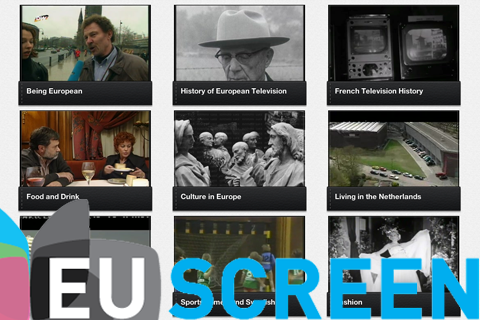
Until November 1st, you can vote for EUscreen to win the People's Lovie Award: the Award for the Best of the EU web. Cast your vote and celebrate audiovisual heritage at www.peopleslovie.eu
EYE Film Institute Netherlands celebrates the World Day
 This year, celebrating the day for the first time in its new grand building, EYE will undertake various actions to draw its visitors’ attention to the vulnerability of audiovisual heritage.
This year, celebrating the day for the first time in its new grand building, EYE will undertake various actions to draw its visitors’ attention to the vulnerability of audiovisual heritage.
The main screening will be the reprise of DE BERTHA, the recently discovered and restored 1913 film starring the Dutch film diva Annie Bos in one of her earliest surviving roles.
Furthermore, throughout the day, EYEs collection and restoration specialists will be present at the “film heritage” desk at the entrance, showing and telling before/after sequences from restorations, and answering questions about film preservation and EYEs running projects.
All patrons visiting EYE will receive a small gift item, encouraged to participate in quizzes or other activities about film history. Those visiting the film theaters will be surprised with hundred year old short films before the regular film screenings. The EYE shop will feature discounts on a big number of items related to the film collection.
Furthermore, to reach out to a worldwide audience, from 27 Oct. on, EYE will give internet access (through its Youtube channel) to a small selection of its oldest films, from 1897 to 1899.

Frame enlargement from DE BERTHA (1913, NL, Louis Chrispijn sr.)
Hong Kong Film Archive screens "The Valiant Ones"
Early Treasures: Celebrating UNESCO's World Day for Audiovisual Heritage
Presented by: Hong Kong Film Archive
Introduction
Preserving the heritage of Hong Kong cinema has always been a major goal of the Hong Kong Film Archive. In support of the World Day for Audiovisual Heritage, we are presenting one of the Archive's priced titles, The Valiant Ones (1975).
In 2005, the United Nations Education, Scientific and Cultural Organization (UNESCO) designated October 27 of every year as the World Day for Audiovisual Heritage. It is an important part of a global effort to raise awareness of audiovisual documents as an integral part of national identities, the fragility of these documents and the urgent need to protect them.
Film Screening: The Valiant Ones
Dir / Scr: King Hu
Cast: Hsu Feng, Bai Ying, Roy Chiao, Wu Jiaxiang
1975 / Colour / 35mm / Mandarin / Chi & Eng Subtitles / 107min
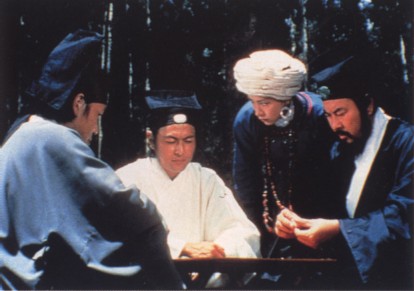
After the success of A Touch of Zen (1971), King Hu returned to Hong Kong to work on two wuxia films: The Fate of Lee Khan (1973) and The Valiant Ones (1975), which took on totally different approaches. The former centres around the studio setting of an inn, while latter tries out another aesthetic treatment by using mostly location shooting around deserted islands or the countryside. The plot is simple: central Government sends a bunch of officials to clean up invading Japanese pirates, prompting a series of tactics, conspiracies and strategic workings to surface. Besides a tragic plot that gradually reveals treachery, cunning traps and tricky scheming, the film is a must-see if you are keen on martial arts choreography that creatively deploy editing skills like jump cuts, rhythmic portrayal of action and unusual camera perspectives. This is a film that carries not only the signature of King Hu, but also his belief that the righteous fighters will leave their marks in history.
This screening is showing a brand new copy that just went through wet-gate printing this year. Special thanks to Mr Raymond Chow who has sponsored the printing process of this film.
Screening Schedule
Date: 27/10 (Sat)
Time: 14:00
Venue: Cinema, Hong Kong Film Archive
Website: http://www.lcsd.gov.hk/ce/CulturalService/filmprog/english/2012et/2012et...
Municipal Archives of Granollers (Catalonia) marks the day
Granollers 1972, de Joan Corbera
Canvi de noms dels carrers, 1977, de Lambert Botey.
Thursday, October 25 at 20pm. Centre Cultural de Granollers, c.Joan Camps, 1
The Municipal Archives of Granollers, in collaboration with the Cultural Association of Granollers screened two documentaries, donated by the authors to the Archive, showing images and events of the recent past of the city.
Documentation of films from the Municipal Archive
Friday 26 October at 9.30. Can Puntas, c. Sta. Elizabeth, 16
Work session opened with the aim of documenting “Eleccions 1977” one of the films that the Archive has in its audiovisual section.
- More information (PDF)
- web site: http://www.granollers.cat/arxiu
National Preservation Office Te Tari Tohu Taonga (NZ) workshops
To coincide with World Day for Audiovisual Heritage the National Preservation Office Te Tari Tohu Taonga (NZ) is holding two 1-day workshops on the Preservation of Audiovisual Collections in late October and early November and releasing a new publication Digitisation of heritage audio collections. A Māori language translation Te whakarorohiko kohikohinga pūoro tuku iho will be released later in the year.
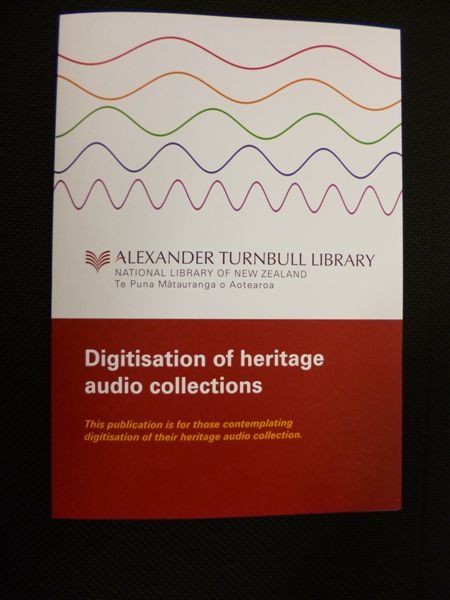
New publication released October 2012
AMIA's reception and special screening at DAS 2012
AMIA will host a special screening and reception to celebrate World Day for Audiovisual Heritage on October 26, 2012, as part of AMIA's Digital Asset Symposium.
Venue: Linwood Dunn Theatre, Hollywood, CA, USA
The reception will be followed by the screening of Disney's TRON (1982), considered one of the precursors of film's digital era. TRON is a look back to the early years of the Digital Era and to remind us how quickly times have changed, and a good way to celebrate World Day for Audiovisual Heritage.
Archiving case studies from Photographic and Audiovisual Archives Group (PAAG) of ICA
A new resource has been developed and coordinated by the Photographic and Audiovisual Archives Group (PAAG) of the International Council on Archives (ICA).
This is a project based on cases studies in which specific archival interventions realized on photographic and audiovisual collections are analysed. The aim is to create a methodology based on real experience. The resource is aimed mainly at the international archival community.
http://www.ica.org/9531/activities-projects/cases-studies.html
Belgiums' public broadcaster RTBF digitises its archive
65,000 hours of VHS and DAT in RTBF's archive have been scanned.
Within the 6th World Day for Audiovisual Heritage, a "Night of archives" of RTBF will be held on Three, Saturday, October 27, from 9:05 p.m. until Sunday at 6am.
radio podcast: http://www.rtbf.be/info/emissions/article_expresso?id=7863586
Le 27 octobre, c'est la journée mondiale du patrimoine audiovisuel. On en parle avec Jean-Louis Rollé, patron de la Sonuma, société en charge de la numérisation des archives de la RTBF.
(October 27 is World Day for Audiovisual Heritage. We talk with Jean-Louis Rollé, head of Sonuma who are digitizing the RTBF archives)
Biblioteca de Catalunya commemorates Catalan composers lives
Since 2006, the Biblioteca de Catalunya has contributed to the celebration of the World Day for Audiovisual Heritage on October 27th.
This year we commemorate various events related to Catalan composers lives. Among them, it is the 25th anniversary of Manuel Blancafort's death, from whom we wish to divulge two musically and heritage significant documents: Homage to Chaplin (from "American souvenir," 1923) and L'orgue de cavallets (the first part of the suite "Parc d'Atraccions", 1924) recorded in piano rolls.
Manuel Blancafort (1897-1987) was the son of Joan Baptista Blancafort, owner of a Spa in La Garriga, a village not far away from Barcelona. Persuaded by a piano trader in 1905, Joan Baptista Blancafort was engaged in a business to distribute "Angelus" piano rolls. Soon after, he set up his own enterprise, which gave him worldwide recognition for the quality of this production, the "Rollos Victoria". Thanks to the collaboration with one of his brothers, he could export music off (namely Argentina, where the rolls are marketed under the name "Best"). "Rollos Victoria" was the first factory pianola rolls who settled in Spain but unfortunately, and due to the civil war, all documents related to this business are missing.
Manuel Blancafort, made a trip to New York and Chicago to learn firsthand some of the new technology to make piano rolls. He boarded the liner "Mauretania" in July 1923. As a result of the experience of this trip, he wrote Transatlàntic en ruta and Homage to Chaplin, a couple of fresh and almost pictorial works in nature, due to the sound palette of the first title and the mute- film-liker rythm of the second one.
In 1924, the Catalan pianist Ricard Viñes premiered "Parc d'Atraccions" in Paris, a suite that will be released worldwide. L'orgue de cavallets needs three staves to be printed, evoking the turn of Carroussel. The title refers to the instrument used to make the music sound while the carroussel is spinning. Both this instrument and the player piano have a certain similarity, for both involve air (sucked or issued).
The two rolls with works by Manuel Blancafort arrived at the Biblioteca de Catalunya in October 2000, together with other funds donated by the daughter of the composer, Camil·la Blancafort.
You can listen to the audio files at http://www.bnc.cat/El-Bloc-de-la-BC.
Margarida Ullate I Estanyol
Sound and Audiovisual Unit
Biblioteca de Catalunya
Barcelona (Catalonia, Spain)
Canadian Commission for UNESCO on the urgency of AV preservation
Les documents audiovisuels, tels que les films, les émissions télévisées et radio, les enregistrements audio et vidéos, contiennent les archives principales des 20e et 21e siècles. La préservation de ces documents est essentielle à la mémoire de l'humanité.
Pour sensibiliser le public aux défis reliés à la préservation du patrimoine audiovisuel, l'UNESCO célèbre la Journée mondiale du patrimoine audiovisuel le 27 octobre.
Dans ce message produit par la Commission canadienne pour l'UNESCO, Marcel Caya, président du Comité ad hoc canadien de Mémoire du monde nous parle du patrimoine audiovisuel et de l'urgence de le préserver.
In this message produced by the Canadian Commission for UNESCO, Marcel Caya, Chairman of the Ad Hoc Committee of Canadian Memory of the World talks about audiovisual heritage and the urgency of preserving it:
Carnegie Hall preserves its historic collections
Carnegie Hall's Archives team is in the midst of a major project to digitize the Hall's extensive collections.
The first televised event at Carnegie Hall took place on December 10, 1949, when United Nations Human Rights Day was celebrated with an all-star line-up that included Aaron Copland, Leonard Bernstein, Sir Laurence Olivier, Yehudi Menuhin, and the Boston Symphony Orchestra. Carnegie Hall's Archives owns a copy of the event program, as well as a rare group photograph of the previously mentioned foursome backstage. But to date, a copy of the televised event has not been found, if it even still exists.
Carnegie Hall, located in Manhattan in New York City, USA, will soon be reformatting most of its existing audiovisual holdings under its Digital Archives Project. Priority is being given to the oldest and most at-risk formats, such as 16" lacquer disks and acetate films from the 1950s. By next year's World Day of Audiovisual Heritage, they hope to share samples of some of the content online.
Read the full blog post at:
http://www.carnegiehall.org/BlogPost.aspx?id=4294990213
Centre for Image Research & Diffusion (CRDI), Girona, presents virtual exhibitions
The Centre for Image Research and Diffusion (CRDI) of the Girona City Council, as part of the celebration of World Day for Audiovisual Heritage, presents the virtual exhibitions:
"Girona – Gävle: On the shores of two seas. From the Mediterranean to the Gulf of Bothnia. 1880-1914"
The aim of this exhibition is to show the different European cultural identities through the analysis of photographs from both cities in this period.
http://www.girona.cat/web/sgdap/WEB_Girona_Gavle/english/index.html

Inauguration of the virtual Photography Museum of Girona
The Centre for Image Research and Diffusion (CRDI, abbreviated in Catalan) of the Girona City Council, as part of the celebration of World Day for Audiovisual Heritage, inaugurates the Photography Museum of Girona (MFGi, abbreviated in Catalan), a new virtual museum available through mobile devices (iPhone and iPad) and through the website.
https://itunes.apple.com/es/app/museu/id565899272?mt=8
http://www.girona.cat/sgdap/cat/MFGi.php
This museum has the aim to exhibit the most representative images of Girona Photography History. From now you can visit the first gallery, devoted to the work of the photographer Josep Buil Mayral (Girona, 1920 - Eivissa, 2005).
Also, we have made available four audiovisuals with CRDI footage, which show the evolution of four emblematic places in the city: the Cathedral, the Rambla, the Devesa and the Independence square:
“The light of cinema”
As part of the celebration events of the World Day for Audiovisual Heritage, the Girona City Council through the Cinema Museum and with the collaboration of the Centre for Image Research and Diffusion (CRDI, abbreviated in Catalan) presents the audiovisual series “The light of cinema” through The Audiovisual Heritage website: http://www.girona.cat/sgdap/cat/CRDI_Cronologies/angles/index.html These series consists of 28 short clips about the history of pre-cinema. They show how the original devices, all them from the museum collection, work.
Reading of texts by the writer Josep Pla
Another event for the World Day is the dramatized reading of texts by the writer Josep Pla that evoke different places of the city. The reading will be accompanied by the screening of a selection of images from the period.
Chile's Cineteca Nacional pays tribute to Mexican cinema
From 24 to 31 October, the Cineteca Nacional hosts a special programme dedicated to Mexican film heritage
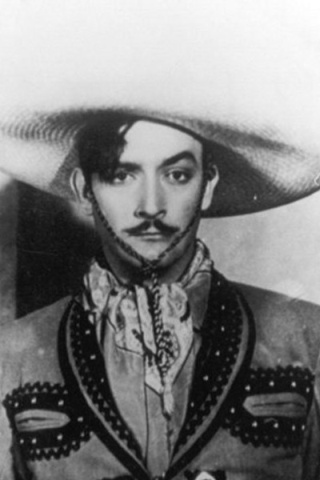 With a week of special programming the Cineteca Nacional celebrates Audiovisual Heritage Day (Día Patrimonio Audiovisual), commemorated on 27 October. This time we pay tribute to Mexican cinema, from the time of the revolution until the 80s, regarding the presentation of the Chilean film by Mexican director Joselito Rodriguez, I sell black eyes, filmed in 1947 and recently restored by the Cineteca Nacional. Rodriguez also is exhibited Ay Jalisco, No Te Rajes, starring Jorge Negrete,
With a week of special programming the Cineteca Nacional celebrates Audiovisual Heritage Day (Día Patrimonio Audiovisual), commemorated on 27 October. This time we pay tribute to Mexican cinema, from the time of the revolution until the 80s, regarding the presentation of the Chilean film by Mexican director Joselito Rodriguez, I sell black eyes, filmed in 1947 and recently restored by the Cineteca Nacional. Rodriguez also is exhibited Ay Jalisco, No Te Rajes, starring Jorge Negrete,
Other reels presented are History Mirada, filmed by the Alva brothers during the Mexican Revolution in the second decade of the 20th C (UNAM archive); Eisenstein's classic, Que Viva Mexico!, 1931, and Come with Pancho Villa (Fernando Fuentes), 1935. Furthermore, Canoeing (Felipe Cazals, 1975); St. (Antonio Moreno, 1931) and The Passion Berenice (Jaime Humberto Hermosillo, 1975).
http://www.ccplm.cl/sitio/2012/dia-del-patrimonio-audivisual/
- Yo Vendo unos Ojos Negros, Joselito Rodríguez, Chile, 1947.
24, 27 y 31 de octubre / 17.00hrs. - Canoa, Felipe Cazals, 1975, 35mm.
25 y 30 de octubre / 17.00hrs - La Pasión según Berenice, Jaime Humberto Hermosillo, 1975, 35mm.
26 y 28 de octubre / 17.00hrs - Playa azul, Alfredo Joskowicz, 1991.
29 de octubre / 17.00hrs - La Historia en la Mirada, archivo UNAM
24 y 31 de octubre / 14.15hrs. - Santa, Antonio Moreno, 1931
25 y 30 de octubre / 14.15hrs - Que Viva México, Sergei Eisenstein, 1931
26 de octubre / 14.15hrs - Vámonos con Pancho Villa, Fernando Fuentes, 1935
27 de octubre / 14.15hrs - Ay Jalisco No Te Rajes, Joselito Rodríguez, 1941. (Con Jorge Negrete)
28 de octubre / 14.15hrs - María Candelaria, Emilio Fernández, 1943
29 de octubre / 14.15hrs
Cinematica Brasileira showcases rare Brazilian films
São Paulo, 27 October:
Cinemateca Brasileira and the International Film Festival of São Paulo gather once again to celebrate the World Day of Audiovisual Heritage. Instituted by the 33th General Conference of UNESCO, the date is celebrated by film archives and film archives of various countries, with the support of the International Federation of Film Archives - FIAF, and seeks to draw the attention of civil society and governments to the need to preserve of film material, television and radio around the world.
This programme to celebrating the date brings classics and rarities of Brazilian cinema restored or preserved by the institution.
The selection includes the films As amorosas, one of the most powerful works of Walter Hugo Khouri filmography, Adultério à brasileira, by Pedro Carlos Rovai, comedy forerunner of our famous "pornochanchadas", Bebel, garota propaganda, by Maurice Capovilla, a drama based on the novel Bebel que a cidade comeu, written by Ignácio de Loyola Brandão, Iracema – uma transa amazônica, by Jorge Bodansky and Orlando Senna, a new classic movie premiered at the 1976 Cannes Film Festival, and the comedy Como ganhar na loteria sem perder a esportiva, by JB Tanko, starring Costinha.
All these classics return to the screen in new 35mm prints made by the Cinematheque.
Events planned in Switzerland
For the official website of the World Day for Audiovisual Heritage 2012 please find here the link to all the events planned in Switzerland for the UNESCO World Day: http://de.memoriav.ch/events/worldday/worldday.aspx
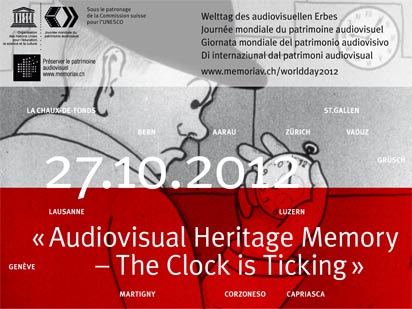
In this context, Memoriav organized a conference on the 26th of October:
Click! Explore? Audiovisual heritage online
Memoriav Kolloquium 2012
University of Lucerne – 26.10.2012
www.memoriav.ch/kolloquium2012
Peter Haber (University of Basel) and Dagan Cohen (director Upload Cinema, Amsterdam) were the keynote speakers. Jean-Bernard Muench, president of the UNESCO Commission of Switzerland and Marie-Chrsitine Doffey, Vice-President of Memoriav and Director of the Swiss National Library were the spakers at the evening reception in the most impressive Bourbakui-Panorama in Lucerne (www.bourbakipanorama.ch). The event finished with the screening of a programme of Upload Cinema presented by Dagan Cohen.
Several events will celebrate the World Day over the next days in all parts of Switzerland. See the programme at: www.memoriav.ch/worldday2012/
FIAT/IFTA's newly funded Archives@Risk programme
This year’s theme for the UNESCO World Day for Audiovisual Heritage October 27th
“Audiovisual heritage memory? the clock is ticking”
draws particular attention to the crisis of time which faces archives worldwide as they strive to save and preserve this precious heritage.
In support of this, and on the occasion of World Day, FIAT/IFTA renews its commitment to helping endangered archives through a newly funded Archives@Risk programme for its members.
This new initiative was announced to delegates at the recent 2012 FIAT/IFTA World Conference in London. Following on the success of the Madagascar FL@H project, FIAT/IFTA believes there is now a demonstrable opportunity to support archives, through collaborative projects, to help save endangered collections as well as to assist in the development and promotion of those archives in a sustainable way.
FIAT/IFTA has committed to an annual fund to be set aside to support projects in member companies to save endangered archives.
Full details of the programme and how archives can be nominated for consideration by the fund will be announced in early 2013.
In addition, as a member of the Co-ordinating Council of Audiovisual Archives Associations (CCAAA), FIAT/IFTA continues to work with its world partners to raise awareness of the plight of endangered audiovisual heritage worldwide through a newly invigorated Archives@Risk world initiative which will see the re-launch of the Archives@Risk website and further cross collaborative initiatives.
Further announcements to come soon.
Galicia screens restored experimental cinema footage
The Xunta de Galicia joins the celebration of the World Day for Audiovisual Heritage and invites the public to experience the experimental images of the artist Eugenio Granell.
The Xunta de Galicia, through its conservation image centers and its network of museums, performs an important role in conservation of materials film, video and photography that are part of the Galician cultural heritage.
Within the task of dissemination of the art audiovisual heritage, the Centro Galego de Arte Contemporánea hosts a sample of experimental cinema by Eugenio Granell, restored by the technicians of the Centro Galego de Artes da Imaxe.
In the last two decades the Xunta de Galicia has been conducting a work of cataloging, conservation and restoration of historic film and photographic material, carried out mainly within the Galician Center for the Arts Image (CGAI) and the network of museums dependent on the Secretariat General culture they have in their funds artworks considered documents asset value.
The recovery of experimental cinema Eugenio Granell
Among the initiatives to disseminate audiovisual artistic heritage, the Galician Center for Contemporary Art hosts will screen until November 4th films by Eugenio Granell: a twenty-minute film, as part of activities to mark the centenary of the intellectual Galician.
More details: http://www.xunta.es/notas-de-prensa/-/nova/3881/xunta-galicia-sumase-cel...
Human Rights Film Festival held in Juba, South Sudan
The staff of the United Nations Mission in South Sudan organised a Human Rights Film Programme from 22-25 October.
The accompanying poster was displayed around the UNMISS base at both Tomping and at the new UN House 10kms from Juba town. The films were well attended and outside UN agency staff came to watch the films.
UNMISS also had a static display of UN photographs at the two restaurants at Tomping with a description of what AV heritage/records are. There is a lot of traffic at those locations so the staff had a few enquiries about the work they do and how they can assist other sections of UNMISS. They developed last year a quick reference guide for staff to manage their 'personal archives' which has proven to be popular in terms of providing advice on preserving personal papers, photographs, music and video. Life in a peacekeeping environment can be unpredictable so staff are keen to know more about this.
Indiana University Libraries Film Archive highlights historical educational films
Here at the Indiana University Library Film Archive (IULFA), we struggle with these issues of decay and obsolescence every day. It’s a challenge that can be particularly poignant and potent when working to preserve and make accessible materials that represent the cultural heritage and history of the area where we live. Handling unique or rare regionally produced materials such as the Indiana University Audio-Visual Center educational films from the 1940s-1980s is unambiguous evidence of the historical and cultural relevance of audiovisual materials.
Those interested in a sampling of some of the educational materials we have available that deal with the Midwest’s cultural and economic heritage in particular might want to take a look at the following films, digitized and made accessible on the IULFA website. These represent only a sliver of the Hoosier-centric materials we are currently accessioning, cataloging, preserving, and digitizing, and we plan to highlight some of this films in upcoming blogs, so stay tuned!
See https://blogs.libraries.iub.edu/filmarch/2012/10/25/iulfa-and-world-day-... for the full blog post commemorating the World Day.
A sample clip is below.
Tales of the Rails, 1990
Lao Cinema Department celebrates the World Day
To celebrate the World Day for Audio Visual Heritage, The Lao Cinema Department:
- made the banner with the slogan : Celebration of the World Day For Audiovisual Heritage , 27 October 2012 , in Lao and in English. We hang it in front of our department (see image)
- sent a documentary film on the film archive (film preservation, repairing, maintenance etc) to Lao National TV3 to make awareness to the public.
Besides, we disseminate
- in our website : www.doc.gov.la (in Lao and English)
- Youtube : https://www.youtube.com/user/laocinema (e.g. see below)
- https://www.facebook.com/Laocinema
Please visit our website!
Library and Archives Canada commemoration
Library and Archives Canada Commemorates World Day for Audiovisual Heritage
To commemorate this day, Library and Archives Canada (LAC) is giving an update on its progress and accomplishments in preserving Canada’s audiovisual (AV) documentary heritage.
To date, LAC has migrated about 41,000 hours of content, which represents about 8% of the estimated 530,000 hours of content detailed in its 10-year AV Migration Strategy. LAC has also opened the new Nitrate Film Preservation Facility and collaborated in the creation of the CPAC Digital Archive: Rewinding the Public Record.
You can learn more about this subject by viewing the video below (also here on LAC’s YouTube channel):
Bibliothèque et Archives Canada commémore la Journée mondiale du patrimoine audiovisuel
Bibliothèque et Archives Canada (BAC) profite de cette Journée pour fournir une mise à jour sur ses progrès et réalisations en matière de préservation du patrimoine documentaire audiovisuel du Canada.
Jusqu’à présent, BAC a migré environ 41 000 heures de contenu, ce qui représente près de 8 p. 100 du total estimatif de 530 000 heures de contenu, tel que détaillé dans sa Stratégie décennale de migration des enregistrements audiovisuels. BAC a également procédé à l’ouverture du Centre de préservation de pellicule de nitrate et a collaboré à la création des « Archives numériques de CPAC : Retour sur les dossiers publics ».
Apprenez-en davantage sur le sujet en consultant cette vidéo sur la chaîne YouTube de BAC.
National Archives of Andorra's video production
The National Archives of Andorra
www.arxius.ad / www.cultura.ad
The National Archives of Andorra participates in UNESCO's World Day for audiovisual Heritage 2012 with a short film:
L’època daurada de Ràdio Andorra. Anys 50 i 60.
We carried out ethnographic research and we used some cinematographic, phonographic and photographic material to produce this video to recover a part of the Andorra's immaterial heritage to celebrate the 27th of October
Audiovisual heritage memory? the clock is ticking / La memòria del patrimoni audiovisual? El temps s’acaba
Arxiu Nacional d'Andorra
National Archives of Australia's audiovisual preservation slideshow
The National Archives of Australia has a vast collection of audiovisual materials, containing over 600,000 items. This collection forms a unique record of Australia's history.
Our team of audiovisual preservation experts work hard to preserve the materials to make them accessible to future generations of Australians.
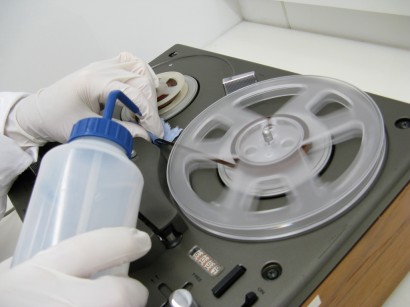
Treatment of mould affected audio
Here's a peek inside our audiovisual preservation labs (click the image below for a slideshow):
Source: http://www.flickr.com/photos/national-archives-of-australia/sets/7215763...
National Library of Israel preserves rare Jewish and Israeli recordings
The Bella and Harry Wexner Libraries of Sound and Song at the National Library are devoted to the preservation of cultural assets that exist in various formats. The Legacy Heritage Fund has facilitated a project to preserve rare Jewish and Israeli recordings. The project involves digitization of records, tapes, and magnetic films, video film and compact discs and even wax cylinder recordings from the early 20th century. The purpose of converting these multiple formats to digital files is to preserve them and ensure their long-term accessibility. The project will make thirty thousand hours of recordings from the treasures of the National Library available for the use and enjoyment of the public.
Source:
https://www.nli.org.il/en/at-your-service/who-we-are/collections/music-collection
National Library of Spain's conference commemorates the World Day
The Biblioteca Nacional de España (National Library of Spain, in Madrid), which has a large collection of sound and audiovisual documents, will hold a conference on October 29th.
The Conference will be divided into two panels which will involve specialists from the Library with librarians from other institutions, professional from Radio Nacional de España, communication experts and professors from universities in Madrid Complutense y Rey Juan Carlos. The event will be presented by Fernando Torra, Deputy Director General of the Biblioteca Nacional de España. The closure and conclusions will be made by Ingrid Kuschick, President of the Asociación Txoke!, which is involved in organizing the event, and José Carlos Gosálvez, Director of Music and Audiovisual at the Biblioteca Nacional.
Details: http://www.bne.es/es/Actividades/Actividadesextraordinarias/conferencias...
Netherlands Institute for Sound and Vision holds its bi-annual Week of Dutch television
A solid sample of television programming in the Netherlands can be given based on information extracted from old broadcasting guides, catalogues, Dutch programmes and individual journal entries that are stored at Sound and Vision. But what about the look and feel of the full-length programming of a television channel in any given time period? The leaders, station calls, announcers and closing programs?
The Netherlands Institute for Sound and Vision has a comprehensive collection of TV recordings, titled the Dutch Television Weeks. Twice a year, the archive records the programming of all national broadcasting stations for an entire week. This collection provides a comprehensive picture of the broadcast programming, including advertising and purchased foreign productions.
Originally, this material was recorded on VHS for study purposes. As of 2009, the Dutch Television Weeks are recorded in files and include 10 channels of national public and commercial broadcasters. In 2013, all VHS will be digitised in the same file format.
2012 marks the 25th year that the weeks of Dutch television are recorded. Traditionally, recording took place in the 10th and 40th week of every calendar year. In honour of the World Day for Audiovisual Heritage, the Institute now announces to move back the autumn Television Week, to annually coincide with this celebration of audiovisual collections worldwide.
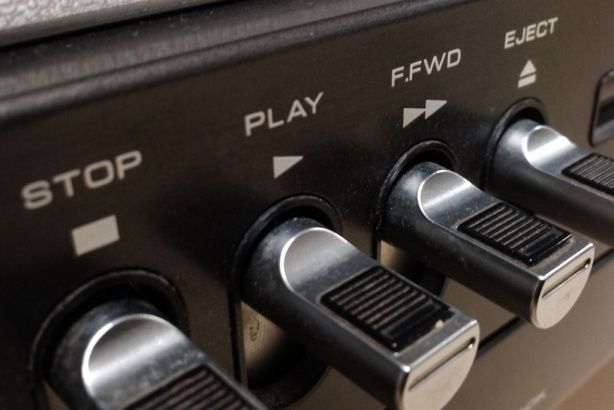
The first VHS deck: JVC HR 3300 (Image: Hans Van der Windt, 2010)
New Zealand's North Ortago Museum uses AV to capture living history
North Otago residents are being urged to investigate the region's rich collection of audio and visual historical recordings, as part of the Unesco World Day for Audiovisual Heritage today.
Read more: http://www.odt.co.nz/regions/north-otago/232150/sounds-past
Phonogrammarchiv repatriates Madagascar’s acoustic heritage
In time for UNESCO’s World Day for Audiovisual Heritage on 27 October the Phonogrammarchiv of the Austrian Academy of Sciences is proud to announce that more than 1,000 sound documents from Madagascar have returned to their country of origin.
The recordings were made between 1961 and 1992 in the course of field research conducted by Lotte Schomerus-Gernböck, Gerhard Kubik, August Schmidhofer and Michael Weber. On behalf of those scholars and the Phonogrammarchiv, August Schmidhofer (Department of Musicology, University of Vienna, and himself a member of the archive’s staff until 1989) handed over a virtual archive on a hard disk containing sound documents of traditional music, fairy tales and stories as well as the respective accompanying documentation.
The repatriation ceremony last September, which took place at the Institut de Civilisations (Université d’Antananarivo) in the presence of Mireille Rakotomalala, ethnomusicologist and former minister of culture, was widely echoed in the local media. Other archives are expected to follow this example.
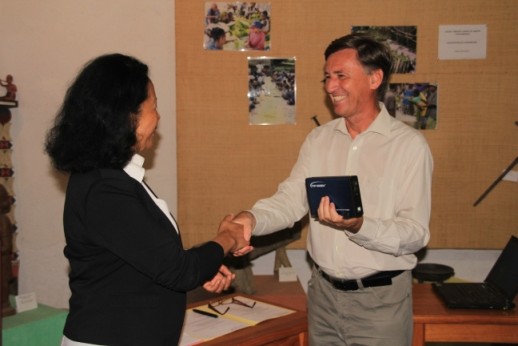
Mireille Rakotomalala and August Schmidhofer (Antananarivo, 26 September 2012)
Since its foundation in 1899, the Phonogrammarchiv has been committed to the preservation of the intangible cultural heritage of mankind. This mission has long been accompanied by the responsibility to repatriate the unique recordings made by Austrian researchers in the field and safeguarded for decades by the Phonogrammarchiv (cf. also our ongoing editions, published by the Austrian Academy of Sciences Press).
Somalia's imperilled radio archive
Somalis who return to Mogadishu for the first time since the conflict began 20 years ago often lament that there is little left of the beautiful, cultured city they once knew. Much has indeed changed. However, hidden in a backroom of the Information Ministry is a treasure trove of Somali history – the archives of Radio Mogadishu.
The dark room is crammed full of reels of quarter inch tapes - lovingly filed in their dusty cardboard boxes on the shelves, spilling over onto the desks, tables and floor with their contents written by hand. There are, according to official figures, more than 35,000 tapes in the archives. More than half of them are songs but they also include drama, poetry, religious programmes, speeches and broadcasts in foreign languages including Italian, Arabic and English.
Read more: http://unpos.unmissions.org/Default.aspx?tabid=9744&ctl=Details&mid=1266...
South African Broadcasting Corporation's Media Library focusses on Springbok Radio
The South African Broadcasting Corporation (SABC) Media Libraries will also be taking part this year by a focus especially on our Springbok Radio Revisited collection, the radio material of the former SABC radio station Springbok Radio (http://www.springbokradio.com/), that was handed back earlier this year to the SABC.
http://sabcmedialib.blogspot.co.uk/2012/10/world-day-for-audiovisual-her...
Switzerland's Médiathèque Valais-Martigny screenings
Médiathèque Valais - Martigny / Martigny will hold film screenings and signings on 27 October.
See http://www.mediatheque.ch/valais/autour-reines-dhrens-films-patois-bande... for details
Tahiti's Radio 1 broadcast on safeguarding of AV heritage in Polynesia
27 October is drawing public attention to the need for urgent action, and to recognize the importance of audiovisual documents.
Jean-Francois Cauvin, manager of archival heritage and broadcasting at Tahiti Radio 1, assesses the situation in Polynesia, while the Institut de la Communication Audiovisuelle (ICA) was closed down this year (link to podcast in French below).
http://www.radio1.pf/2012/10/26/sauvegardons-notre-patrimoine-audiovisuel/
Tel Aviv Cinemateque screenings
 On 28th October 2012 an evening program of archival films about the life of Yitzhak Rabin (1922-1995) will be shown by the Tel Aviv Cinematheque.
On 28th October 2012 an evening program of archival films about the life of Yitzhak Rabin (1922-1995) will be shown by the Tel Aviv Cinematheque.
Details (Hebrew):
http://www.cinema.co.il/movies/movie.asp?movieId=8645
Televisió de Catalunya publishes "Discover the Archive" video
Discover the archive, special on TV3, Televisió de Catalunya (Catalonia Television) website.
http://www.tv3.cat/descobreix-arxiuTV3
The Archive of TV3,Televisó de Catalunya, holds a unique audiovisual collection that reflects Catalan history and society of the past 30 years.
Materials digitally produced and broadcast since 2003 are already preserved in their original digital format in the digital archive. Regarding earlier material, in 2006 we began the process of digitizing the old archive in videotapes, to ensure its preservation and access. Already more than 60% of the videotapes of the archive have been digitized and the process continues. The digital archive now contains almost 200,000 hours, of which about 120,000 hours is “born digital” content and about 80,000 hours is of heritage collection digitized content.
As part of the celebration of World Day for Audiovisual Heritage, TV3 published on its website www.tv3.cat a special programme about the archive: "Discover the Archive", that offers a taste of the older materials hold in TV3 archive. It includes a report about the archive and a sample of news and programs broadcast by TV3 in its first years, in the 80's, that are part of Catalonia collective memory, and that have already been digitized to ensure its preservation and access.
It includes a link to EuScreen, European television heritage website, that gives also access to a selection of TV3 archive holdings.
University of Illinois's media preservation guide
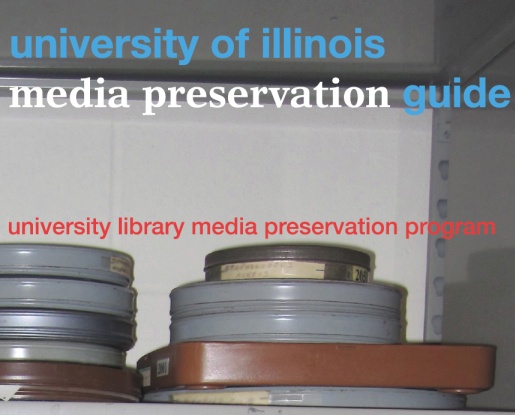
The newly founded program for Media Preservation at the University of Illinois has been actively involved over the past year in surveying and collecting data on media and audiovisual collections across the entire UIUC campus. The Media Preservation program has chosen to commemorate UNESCO World Day for Audiovisual Heritage with the launch of a brochure explaining the importance of audiovisual preservation. This brochure is written for the general public and provides straightforward tips on proper care for media assets. This document will be distributed en masse to each department on campus and it is our hope that this simple guide will help to educate the university community regarding the importance of their audiovisual documents.
The brochure can be downloaded here:
https://uofi.box.com/s/0o0zxm8yhm3dz5rn77s7
http://www.library.illinois.edu/prescons/services/media_preservation/med...
Valencia (Spain) Radio-TV on the importance of AV heritage
The Documentation Unit of RadioTelevisió Valencia states the importance of our audiovisual archives and their preservation for present and future generations of Valencia.
Cultural heritage is the legacy we receive from our ancestors and it is our duty to preserve it and care for it to be transmitted to our children. The audiovisual heritage is, for more than a century, the best tool to reflect how societies have evolved.
Heritage is and should be protected by law, in the case of Valencia, Valencia Protection of Cultural Heritage and its classification is contained in Law 5/2007 amending Law 4/1998 of June, the Government Valencia, Valencian Cultural Heritage.
RTVV is part of the cultural heritage of Valencia and it includes much of the memory of Valencia, from the creation of RTVV in October 1989 to the present. And continues to grow every day.
Workshop and screenings at Centro de Referência Audiovisual, Belo Horizonte, Brazil
The Fundação Municipal de Cultura, through the Centro de Referência Audiovisual (CRAV) prepared a series of activities to celebrate the World Day for Audiovisual Heritage, celebrated on October 27. Among the actions are a workshop of audiovisual heritage conservation, held at the CRAV headquarters, and a showcase of films at the Centro de Cultura Belo Horizonte (CCBH). All activities are free.
The workshop Preventive Conservation of Audiovisual Cultural Heritage will be held 29-31 October, from 14h to 17h. It will be a practical lesson of film analysis with the aim of introducing the participants in the world of film preservation.
On October 29 and 30 at 18h, the Centro de Cultura Belo Horizonte, presents a series of short films that portray aspects of film production and audiovisual exhibition in Belo Horizonte over the years. On the 29th: Experiência Cinematográfica (BRA, JA Ribeiro, 1980, 10min.); O Homem e a Moviola (BRA, JA Ribeiro, M. Furtado and S. Nogueira, 2011, 19min.); Guardados (BRA, Ophicina Digital, 2003, 13min.), and on the 30th: Salas (BRA, Ophicina Digital, 2003, 12min.); Bonfioli, o Fazedor de Fitas (BRA, Ophicina Digital, 2003, 17min.) Elementos (BRA, Ophicina Digital, 2003, 27min.) Reminiscências (BRA, A. Junqueira, 1909-1922, 7 min.).
http://portalpbh.pbh.gov.br/pbh/ecp/noticia.do?evento=portlet&pAc=not&id...
Online educational platforms of the Netherlands Institute for Sound and Vision
The World Day for Audiovisual Heritage on October 27 provides an occasion to raise general awareness of the need to take urgent measures and to acknowledge the importance of audiovisual documents.
The online educational platforms ED*IT BASIS, LES 2.0 and Academia of the Netherlands Institute for Sound and Vision are paying attention to the World Day for Audiovisual Heritage. ED*IT BASIS (primary education), LES 2.0 (secondary education) and Academia (higher education) provide online access to thousands of hours of video and audio which have been made available thanks to the digitisation efforts in the framework of the Images for the Future project.
These unique materials are contextualised and made available for educational purposes.
To complement the World Day for Audiovisual Heritage, ED*IT BASIS pays special attention to the content folder Time of television and computer containing audiovisual resources from the start of Dutch television until now.

LES 2.0 brings the online digital lesson Into the lions den about wildlife filmmaker Hugo van Lawick into the limelight.

Academia provides the content folder Radio and Television History where teachers and students can find a vast selection of important Dutch television and radio broadcasts.
All this material is digitized, contextualised and retained to educate future generations.
Open House at Moving Image Research Collections (MIRC), University of South Carolina
Open House at MIRC–Friday October 26th 2012
In honor of World Audio Visual Day, held annually on October 27th, MIRC will be conducting an Open House event for the public. It will be taking place from 3pm-5pm this friday and all are welcome.
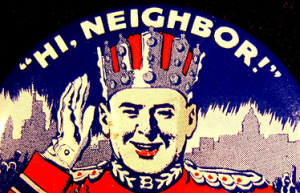 Come one and all if you would like to see behind the scenes of a Film Archive. It is free to attend and no one will be turned away however if you would like to participate in any of the events planned then we do ask that you email us or RSVP in some way – either by phone or electronic device since numbers are limited for group sessions.
Come one and all if you would like to see behind the scenes of a Film Archive. It is free to attend and no one will be turned away however if you would like to participate in any of the events planned then we do ask that you email us or RSVP in some way – either by phone or electronic device since numbers are limited for group sessions.
In an environment perfect for learning about film and video, visitors can tour the MIRC facility with a film curator, attend workshops on film handling and video identification, and experience a re-creation of a vintage classroom film screening. There will be refreshments, door prizes and knowledgeable film experts happy to answer questions.
“This Open House, which is our first, gives the University community an opportunity to experience firsthand the fascinating work of audio-visual preservation,” said MIRC Director Mark Cooper. “Anyone who has ever wondered what it takes to get a video on mirc.sc.edu should come by to find out.”
MIRC’s Open House event is free and open to the public, but seating is limited for the tours, workshops and screening. To register, email: mirc@sc.edu.
MIRC is located at 707 Catawba Street, adjacent to the USC campus. For more information, visit http://library.sc.edu/mirc/
http://library.sc.edu/blogs/mirc/2012/10/22/open-house-at-mirc-friday-oc...
Pause and Play at the NFSA
Pause and Play at the NFSA
Celebrate UNESCO World Day for Audiovisual Heritage as you discover Australia's living archive. Explore behind-the-scenes in our preservation laboratories; create your own horror movie mask; relax in the Grace Gibson Listening Lounge; enjoy sounds from across the ages with DJs in the art deco courtyard; and discuss The Good, The Bad and The Ugly in film.
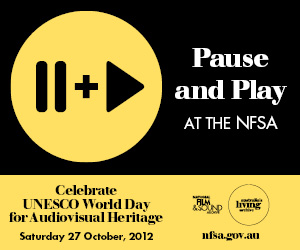
Bring the family to a free screening of beloved Australian film Storm Boy and movie buffs can settle in for a marathon with The Story of Film: an Odyssey.
See the full program at www.nfsa.gov.au
When: Saturday 27 October, 1:30pm to 9pm
Where: National Film and Sound Archive, McCoy Cct, Acton, ACT
Information: 1800 067 274
Poland's National Audiovisual Institute celebrates with Culture 2.0 Festival
An interdisciplinary Culture 2.0 Festival will be held in Warsaw on the 26th and 27th of October at the National Audiovisual Institute (NInA) premises. The motto of this year's sixth edition of the event will be the network citizen and the culture civic dimension. Each year Culture 2.0 is the focal point of Polish celebration of the World Day for Audiovisual Heritage established by UNESCO and falling on October 27.
A two-day Culture 2.0 festival will begin in Warsaw on the eve of the World Day of Audiovisual Heritage established by UNESCO, that is on the 26th October. The event is organized for the sixth time by the  National Audiovisual Institute, a state cultural institution whose mission is to digitize, share and promote Polish audiovisual heritage. The Institute continuously takes action in the field of research, media and audiovisual education, and so called Culture 2.0 activities. Culture 2.0 is a term referring to the creation of a new culture cycle, shaped by the digital media experience and the opportunities offered by the media.
National Audiovisual Institute, a state cultural institution whose mission is to digitize, share and promote Polish audiovisual heritage. The Institute continuously takes action in the field of research, media and audiovisual education, and so called Culture 2.0 activities. Culture 2.0 is a term referring to the creation of a new culture cycle, shaped by the digital media experience and the opportunities offered by the media.
A detailed festival program is available at www.culture20.eu.
Press release for more details.
Rwanda's Iriba Center organises a week of activities
Towards the Sources of History: IRIBA Center Organises Seminar on Audiovisual Archives in Rwanda
In celebration of the World Day for Audiovisual Heritage 2012, the IRIBA Center for Multimedia Heritage, Rwanda, is organising a week-long series of workshops and events to raise awareness about audiovisual archives in Rwanda and highlight their importance in understanding the past and building a conflict-free future. From films and photographs to radio and sound texts, archival documents play a vital role in the reconstruction of the state and the reappropriation of history and cultural identity. With this seminar, the IRIBA Center aims to create a space of exchange and discovery around archives and to sensitise the Rwandan public on the various audiovisual materials that exist inside and outside the country.
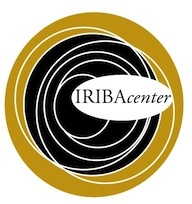 From October 23-34, the IRIBA Center will hold a workshop entitled “Memory and Architecture” at the Kigali Institute of Science and Technology (KIST). In a country in the process of reconstruction, the urban landscape is changing quickly. What memories can we keep of places and buildings of yesterday and today? Is there an architectural memory in Rwanda?
From October 23-34, the IRIBA Center will hold a workshop entitled “Memory and Architecture” at the Kigali Institute of Science and Technology (KIST). In a country in the process of reconstruction, the urban landscape is changing quickly. What memories can we keep of places and buildings of yesterday and today? Is there an architectural memory in Rwanda?
In partnership with the Goethe Institute, a BrainSTORM debate, “The Future of the Past: The Survival of Rwanda’s Historic Documents”, will take place on October 25. Representatives from the International Criminal Tribunal for Rwanda (ICTR), the Rwanda Bureau for Information and Broadcasting (ORINFOR), the Ministry of Sports and Culture (MINISPOC), the Institute of Research and Dialogue for Peace (IRDP), and KIST will discuss the irreplaceability of historical documents and the challenges facing their conservation and usage. How can the ICTR Archives and other archival materials about Rwanda be safeguarded, valued, and placed at the disposal of both Rwandan and international historians? How can archives within the country be located and protected? How can archives outside the country be repatriated?
From October 26-7, IRIBA will host a workshop entitled “Towards the Sources of History”. Participants, including international and local experts and Rwandan students and film-makers, will work on mapping the potential archives in Rwanda and strategize ways to locate at-risk materials. Documentary films on archives will be screened and discussed. Debates and musical performances will also be incorporated into the programme.
All activities will take place under the patronage of the President of the Rwandan Senate, the Honourable Jean Damascène NTAWUKURIRYAYO. The Rwanda National Commission for UNESCO will be among the guests of honour.
The IRIBA Center for Multimedia Heritage, whose names means “the source” in Kinyarwanda, gathers together films, photographs, and audio recordings dating from the start of colonial rule in East Africa, more than a century ago, to the present day. Since 1994, all Rwandans share genocide as their central legacy. As they search for a path to long-lasting recovery and peace, discovering—or re-discovering—their common history and cultural identity is essential to moving forward and to consolidating peaceful coexistence. IRIBA’s goal is to give free and open access to that history in picture and sound.
Audiovisual materials are an important part of any country’s historical and cultural legacy. But in Rwanda, where many do not read or write, less than a generation after the most efficient genocide of the twentieth century, these resources will play a critical role for future generations to learn about their past as they build towards a common future.
Screenings at the Museum of Modern Art, New York
The Moving Image Archiving and Preservation Program hopes you will join us for an afternoon of screenings at the Museum of Modern Art to celebrate:
World Day for Audiovisual Heritage
Electing Change: Images and Sounds of Political Transition
The Museum of Modern Art
The Roy and Niuta Titus Theater, T2
Saturday, October 27th, 2012, 1:00 - 3:00 pm
The Moving Image Archiving and Preservation Program at New York University has brought together a variety of material from archives around New York City in celebration of UNESCO’s World Day for Audiovisual Heritage. This event is part of To Save and Project: The 10th MoMA International Festival of Film Preservation. This is the second annual World Day for Audiovisual Heritage to be held at The Museum of Modern Art under the direction of MIAP.
The 2012 Program Line-up:
- New York Public Library Reserve Film and Video Collection: Tellin’ the World
- Democracy NOW!: Footage from the Occupy Wall Street Movement
- StoryCorps Archive: Edited and unedited archival interviews
- Jim Hubbard: Excerpt from United in Anger: A History of ACT UP
- Gartenberg Media Enterprises: Film and audio from the Kennedy Campaign
- WITNESS: Excerpts from Russ Dove interview; Excerpts from Sierra Leone Election Rally
- United Nations Multimedia Resources Unit: UN Election Monitors Deploy in South Africa; Elections in Burundi
- Human Rights Watch: Uprising: The Arab Spring
- Panel Discussion

Uprising: The Arab Spring / © 2011 Yuri Kozyrev/ NOOR for Time
In consideration of the forthcoming U.S. elections, these pieces were chosen because they represent perspectives of democracy, political struggle, and shifts of power that have played significant roles on the local, national, and global levels. From a 1970’s educational short encouraging and instructing young New York City residents to vote, to captivating scenes from Arab Spring demonstrations, the 2012 program exemplifies the many facets and complexities surrounding political practices throughout history and across the world.
Additionally, the importance of preserving and providing access to these materials plays a role in how they may become utilized as archival footage in a number of different capacities. Following the screening, a panel comprised of individuals in the fields of archiving and production will take part in a Q&A surrounding the use of political footage in alternative creations.
MoMA ticketing policies apply. Please visit http://www.moma.org/visit/plan/#filmticketing for more information.
Moving Image Archiving and Preservation Program: http://www.nyu.edu/tisch/preservation/
The Association of Moving Image Archivists Student Chapter at New York University: http://amiastudentsnyc.com/events/
Please contact wdavh2012@gmail.com for more information.
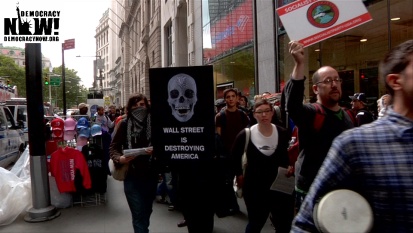
Democracy Now! (2011 Sam Alcoff / Democracy Now!)

United in Anger: Mark Fotopoulos (1956-1991) holding his iconic sign.

A giant banner reads “Money for AIDS not for War.” Released during a mass occupation at New York City’s Grand Central Station.
ADDITIONAL PRESS:
AMIA @ NYU page:
http://amiastudentsnyc.com/events/events/world-day-for-audiovisual-herit...
The Museum of Modern Art
To Save and Project: The 10th MoMA International Festival of Film Preservation
http://www.moma.org/visit/calendar/films/1325
Mention on material in New York Times article:
http://www.nytimes.com/2012/10/08/movies/to-save-and-project-the-modern-...
Shanghai Audio-Visual Archives to hold a conference and seminar
Themed event in celebration of World Day for Audio Visual Heritage 2012
The achievements releasing conference and seminar of the project
"Global Collecting for Shanghai’s precious Audio-visual Archives"
Meaning of this event:
On 27th October 2011, in celebration of World Day for Audiovisual Heritage, Shanghai Audio-Visual Archives (SAVA) started up the project "Global Collecting for Shanghai’s precious Audio-visual Archives". In the past one year, SAVA has continuously made new discoveries of historical moving images reflecting Shanghai's changes and has collected them from archives and individuals all over the world. What's worth mentioning is that SAVA has made a breakthrough in collecting historical footage through newly developing private channels. The latest collection includes original footage, unedited newsreel material and outtakes which has not only archival value but also heritage value. A city's moving image pieced together by three elements of “people, location and events” recording the city's past and present, meanwhile laying out the vitality of history. Cities have close ties with society and humanity. The evolution of history has formed today's cities whose rise and fall can all be traced. Therefore, the excavation, collection, protection and research of the city's historical moving image definitely are a huge cultural project.
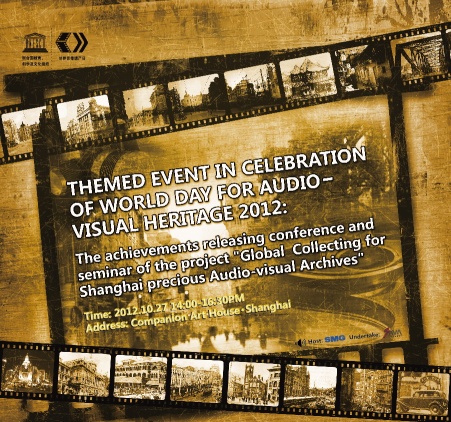
The fundamental purpose of SAVA is to discover and reconstruct the Centennial Chronicles of the city Shanghai's historical moving image. Through our long-term effort on collection, protection, research and spread of the city's moving image, we have accumulated our own experiences and resources and moreover gradually have formed a macro vision in the resources construction of city's moving image. At this conference and seminar, we wish to share our experiences and achievements. And we also hope the industry and academic experts will discuss jointly the multiple possibilities of moving image protection and development so that we can realize the diversified use of historical materials. We believe that we need to have a long-term awareness of a city's dynamic changes and abstract a mature attitude to the recording of historical moving image, thus we can record the future of the city better.
Schedule:
Date and Time: Saturday 27th October 2012, 14:00-16:30 PM
Location: Companion Art House, 195 Guang Fu Road, Shanghai, China.
14:00 - 14:30 Achievement releasing
1, Introduction by SAVA: The project "Global Collecting for Shanghai precious Audio-visual Archives" and its achievement in the past year.
2, Playing carefully chosen historical footage of Shanghai collected through private channels.
3, Awarding certificates of donation to contributors.
4, Speech by the leader of SAVA.
14:30-16:30 Seminar on city's moving image protecting and developing
The experts and scholars attended can speak freely and discuss on the theme.
Participants:
Leaders of SAVA
Delegates of footage collecting team
Consultants of the project
Delegates of contributors
Experts and scholars of related fields from Shanghai's archives, museums, libraries and universities, Media reporters
Special screening at the New Zealand Film Archive
A special screening of the long-lost John Ford film 'Upstream' will be held on the evening of Thursday the 25th October at the New Zealand Film Archive, in an early celebration of World Day for Audiovisual Heritage on the 27 October.
Made in 1927, ‘Upstream’ was considered among over 60 feature films from legendary filmmaker John Ford’s early career that were lost forever. However, in 2009, the film was unearthed by film archivists searching deep within the New Zealand Film Archive’s trove of early nitrate prints. The momentous discovery made headlines around the globe.
Ford's 60 minute long silent comedy film is a "backstage drama" about a Shakespearean actor and a woman from a knife-throwing act. The screening will be accompanied by a pianist.
http://www.aranz.org.nz/Site/events/Conferences/2012_Conference.aspx
Tokyo-based Film Preservation Society adds lectures to its Ustream channel
The Tokyo-based Film Preservation Society celebrates 2012 WD for AVH by showing several lectures from the "7th Film Restoration and Preservation Workshop", which was held on August 2012 at Kyoto Museum, on our Ustream channel:
http://www.ustream.tv/channel/fps-channel
2012.10.26 21:00- JST
Introductory lectures by Yoneo Ota (Professor, Osaka University of
Arts) and Kiyotaka Moriwaki (Kyoto Museum)
2012.10.27 20:00-
Lectures on sound restoration and preservation by John Polito (owner, chief engineer) and Oki Miyano (preservationist) from Audio Mechanics, LA
2012.10.28 20:00-
Lectures on regional film archiving by Kae Ishihara (Film Preservation Society), Haruka Aiso (Bunkyo Film Archive), Daisuke Miyoshi (Sumida 8mm Film Archive/Tokyo University of the Arts), and Noriko Tanaka (Kobe Planet Film Archive)
All the lectures are conducted only in Japanese except for the lecture
by John Polito on 27th.
And also we distribute Tenugui* designed by Haruka Aiso. See image below.
(*http://en.wikipedia.org/wiki/Tenugui)

Viet Nam Film Institute celebrates the World Day
Greetings from Viet Nam Film Institute!
In order to celebrate the World AV Day as well as the 1000th Anniversary of Thang Long - Ha Noi (capital of Viet Nam), Viet Nam Film Institute and its branch in Ho Chi Minh City have organized the follow activities:
- Publishing the bilingual (Vietnamese and English) book "Catalogue of films about Ha Noi".
- Exhibition "Ha Noi in works of cinema" at Ha Noi and Ho Chi Minh city.
- Meeting and exchanging with the crew of making film Hanoi Little Girl.
- Organizing of mobile screenings at: Hanoi Teachers College, Center of Social Labor 5 (Tu Liem district, Ha Noi), Center of Social Labor 6 (Soc Son district, Ha Noi).
- Shooting material of the Opening of Viet Nam's Ethnic Group Cultural and Tourist Village Gate.
- Shooting material of the Opening Ceremony of Thang Long - Ha Noi's 1000 years at Ly Thai To Square.
- Shooting material of the Inaugurating of Saint Giong Statue at Soc Son district, Ha Noi.
- Organizing the Seminar of "Ha Noi in Works of Cinema".
- Holding Ha Noi Film Days at Ho Chi Minh city.
Vojvodina broadcast archives highlights the plight of Serbia's AV heritage
RUV RTV is a Regional Public Broadcasting Service of Vojvodina based in Novi Sad, Serbia, with a rich audiovisual archive since its formation in 1974. This archive is the precious evidence of long term co-existence among a number of national communities peacefully living together in spite of a difficult period Serbia has experienced recently and that is still continuing.
RUV RTV produces and broadcasts program on two channels, RTV1 and RTV2, and three radio frequencies, both 24 hours daily. Programmes are produced and aired in 10 languages: Serbian and nine of the languages of the national communities living in Vojvodina: Hungarian, Slovak, Romanian, Ruthanian, Bosniak, Ukrainian, Roma, Croatian and Macedonian.
The Archive, especially the film department, is endangered, in first place physically, ever since it lost its building after the NATO bombing.
We are determined to present to domestic and foreign public, decision-making people and donors, the desperate situation in which valuable documents exist for more than 13 years now. The archives are kept and maintained as best we can, but it is, as for many similar archives, too slow a process.
The theme for 2012 is: „Audiovisual heritage memory? The clock is ticking” in which our dramatic archive situation perfectly fits.
Our contribution to this Day is the organization of a Multimedia Exhibition dedicated to the condition and perspectives of the RTV Archive. Photos, exhibition pieces, film documentaries and broadcasts and texts should warn the public about the treasure hiding in our Depot’s which is, because the lack of resources and overall poor RTV economic situation, everyday exposed to rapid decay. This actually means forgetting some essential events from the history of multi-ethnic and multicultural Vojvodina’s life.
Opening Exhibition is on 26th October 2012, Friday at 10 a.m. RADIO NOVI SAD STUDIO M of PBS Radio Television of Vojvodina.
Organizer: RUV RTV
http://www.rtv.rs/sr_ci/studio-m/program/